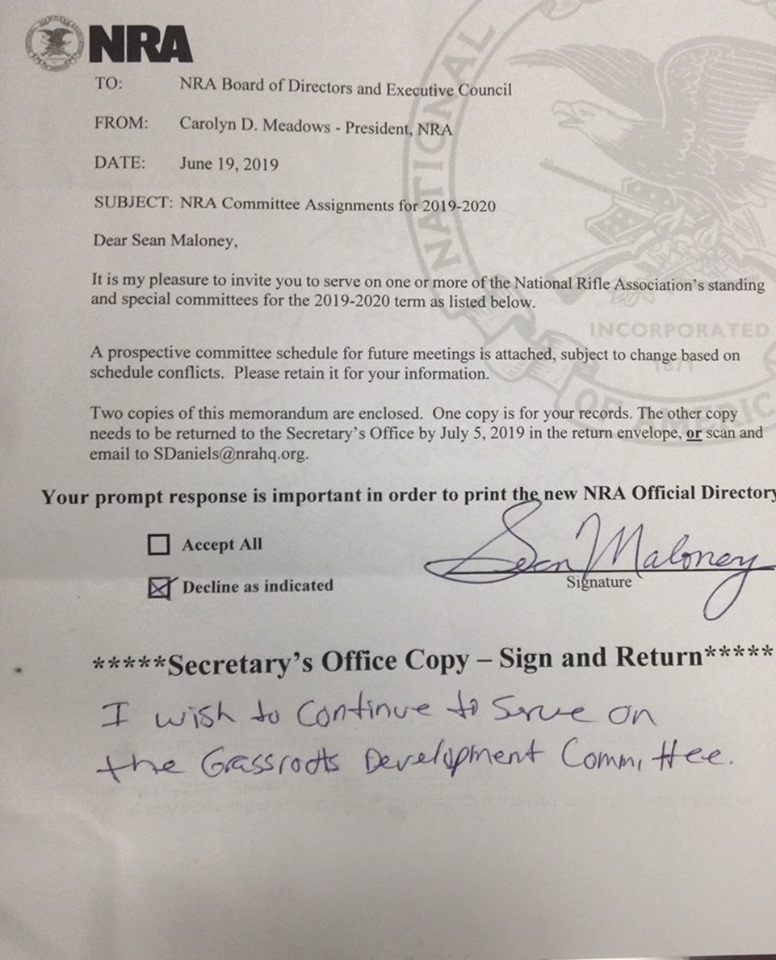The real work of the NRA Board of Directors is done in the various committees. These committees range from the Audit, Finance, and Ethics Committee to Outreach, Federal Affairs, and Legislative Affairs. Officially, it will be new NRA President Bob Barr who selects the members for all these committees. More on that later.
There is also the Special Litigation Committee, the Nominating Committee, and the Executive Committee. This last group of committees had its members selected at the Board meeting after the Annual Meeting. The Special Litigation Committee is, by default, composed of the officers. (see correction) The Nominating Committee is a nine-member committee with reformers holding a 5-4 majority. It will now be chaired by Charlie Beers who is Chairman Pro Tem (highest vote getter).
Going back to 2019, you may remember that a number of reformist Board members were purged from their committee assignments for asking the wrong questions and given no committees upon which to serve. This was done by former NRA President Carolyn Meadows presumably with the approval of then-EVP Wayne LaPierre. Among those purged from their committee assignments were Esther Schneider, Tim Knight, Sean Maloney, Duane Liptak, and Allen West. All five ended up resigning from the Board. This retaliation against these Board members became an issue in the New York trial. The jury found that the NRA had retaliated against them in violation of New York’s whistleblower law. The video deposition of Carolyn Meadows on retaliation helped in this finding.
NRA President Bob Barr has a unique opportunity to show Judge Joel Cohen that the NRA has reformed enough that it will not need a special monitor. He can grab this opportunity if and only if he does certain things. First and foremost, he should consult with Bill Bachenberg and Mark Vaughan on the appointment of committee members and make these appointments in a balanced manner such that reformers are fairly represented. For example, I think Rocky Marshall, one of the Four for Reform, has the requisite knowledge and experience to be valued addition to the Finance Committee. Likewise, who better than a judge like Phil Journey to serve on Legal Affairs. Additionally, the appointment of the chair and vice chairs of the committees needs to be even handed.
Second, Barr needs to be transparent in his appointment of committee members. In the past, the composition of committees was rarely, if ever, disclosed. This needs to change. The members of the NRA deserve to know who is serving on each and every committee whether it is a Board member or an outside appointee.
Finally, and this is a critical point, Charles Cotton and David Coy must not be allowed to continue to serve on either the Audit or Finance Committees. Their abdication of their fiduciary duties while heading the Audit and Finance Committees was one of the reasons that the New York Attorney General’s Office was able to a) bring the lawsuit in the first place and b) successfully win their case with the jury. Allowing either of them to continue to serve on these important committees would send a sign to both Judge Cohen and the membership of the NRA that the leadership of the NRA was not serious about cleaning up the organization. Members and potential members will continue to keep their wallets closed if they remain in place. Frankly, I think the greatest service that they could do for the NRA which they profess to love would be to resign from the Board altogether.
CORRECTION: I was wrong in assuming that the Special Litigation Committee members were selected by position. That is that it was to be composed of the President, 1st VP, and 2nd VP.
According to a Board resolution in January 2021, the SLC was to be composed of Carolyn Meadows, Charles Cotton, and Willes Lee. That all three were officers was merely coincidental. After then-1st VP Willes Lee resigned from the SLC, it was later reconstituted by Board resolution to add David Coy and perhaps Bob Barr.
The key thing to remember about the Special Litigation Committee is that it only concerned matters dealing with the New York Attorney General’s case against the NRA. The rationale for even having it was that given the NRA’s then-CEO/EVP Wayne LaPierre and then-General Counsel John Frazer were named defendants in the case their participation in decision making regarding the case would be a conflict of interest.






